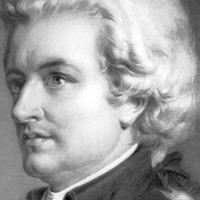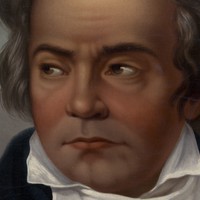Martin Frost leads Mozart, Beethoven and Messiaen


 Listen to Audio
Listen to Audio
The Marriage of Figaro was the first of Mozart’s three collaborations with the Italian librettist Lorenzo da Ponte, who also scripted Don Giovanni and Così fan tutte. It was possibly Mozart’s idea to borrow the scenario from a 1778 French play by Pierre Beaumarchais, a sequel to his earlier hit, The Barber of Seville (later immortalized in Rossini’s 1816 opera). The farce was banned in Vienna at the time for its sarcastic condemnation of the aristocracy, and da Ponte had to scrub the work of its political overtones to gain the emperor’s approval.
The Marriage of Figaro transpires over the course of “one crazy day.” Figaro, the head servant to Count Almaviva, is due to wed the maid Susanna, who meanwhile has been subjected to the Count’s lecherous advances. In the end, the Count gets his comeuppance, and Figaro and Susanna marry. Although the music of the overture has no major presence later in the opera, it sets the scene for the hilarity that ensues. The overture’s form is quite lean, with neither a repeat of the exposition nor a development section. The frenetic Presto tempo and persistent eighth-notes give the prelude a breathless feeling throughout its four-minute sprint, while rising figures and drawn-out crescendos establish the buoyant tone of the opera.
Aaron Grad ©2013
 Listen to Audio
Listen to Audio
Ludwig van Beethoven’s first two symphonies took their cues from Franz Joseph Haydn, the formidable “father of the symphony” and Beethoven’s teacher for a short while after he moved to Vienna. Soon enough, Beethoven honed a symphonic voice that eclipsed even Haydn’s in its scale and grandeur, beginning with the massive Symphony No. 3 (Eroica) from 1803 and continuing in the fateful Symphony No. 5 from 1808. Sandwiched between those landmark symphonies was a smaller specimen, the Symphony No. 4 in B-flat Major, underscoring Beethoven’s lasting debt to Haydn.
Beethoven composed the Fourth Symphony in mid-1806, and he first unveiled it at a private concert in March 1807. Close followers of Haydn’s London symphonies might have noted Beethoven’s nod to the Symphony No. 102, which likewise begins with a held B-flat in octaves. Whereas Haydn made a subtle detour to B-flat minor in his introduction, Beethoven fully embraced the move to the minor scale, until the harmonies sneak back to the major key via one of the score’s many slippery and surprising transitions, launching the Allegro vivace body of the movement.
The Adagio begins with an introductory figure that seems to have lingered from the end of the first movement, preparing the way for a sweet, singing melody. The third movement was labeled a Minuet, but the quick and boisterous music is really a scherzo in all but name, representing Beethoven’s faster and wilder take on Haydn’s dancing diversions.
Beethoven’s finale is full of Haydn’s impish wit, and it saves the best punch line for the end, when the violins, as if thoroughly exhausted, slowly trudge through the main theme one last time. After a similarly lethargic response from the bassoons and then the cellos and basses, the group rallies to end the symphony with an energetic flourish.
Aaron Grad ©2022

The composer Olivier Messiaen was serving in the French military in 1940 when he was captured amid the Nazi invasion. He was transferred to a prisoner-of-war camp in Silesia known as Stalag VIIIA, where among his fellow inmates he found accomplished musicians who played violin, clarinet and cello. With the help of a sympathetic guard, Messiaen obtained paper, a pencil and a quiet space in which to compose, and he even convinced his captors to bring in an upright piano so that he could perform with his colleagues. On January 15, 1941, the motley quartet performed Messiaen’s newest work for a rapt audience of prisoners and guards alike in a frigid, unheated barrack.
The work first heard on that extraordinary day was Quatuor pour la fin du temps, or Quartet for the End of Time. The title came from a passage in Chapter 10 of the Book of Revelation, in which a “mighty angel … cried in a loud voice … that there should be time no longer.” Messiaen was a devoted Catholic, and music was a prime vehicle for his faith and mystical worldview. He was also a birdsong collector, a student of the modes and rhythms of Eastern music, a synaesthete (meaning that his brain mingled sensory inputs of sound and color), and a composer and organist with the finest training from the Paris Conservatoire — all of which can be heard and felt in Quartet for the End of Time.
The quartet consists of eight disparate yet interrelated movements. In a preface to the published score, Messiaen gave a detailed account of each movement’s origins and meanings:
I. Liturgy of Crystal. Between three and four in the morning, the awakening of birds: a solo blackbird or nightingale improvises, surrounded by a shimmer of sound, by a halo of trills lost very high in the trees. Transpose this onto a religious plane and you have the harmonious silence of Heaven.
II. Vocalise, for the Angel who announces the end of Time. The first and third parts (very short) evoke the power of this mighty angel, a rainbow upon his head and clothed with a cloud, who sets one foot on the sea and one foot on the earth. In the middle section are the impalpable harmonies of heaven. In the piano, sweet cascades of blue-orange chords, enclosing in their distant chimes the almost plainchant song of the violin and cello.
III. Abyss of the birds. Clarinet alone. The abyss is Time with its sadness, its weariness. The birds are the opposite to Time; they are our desire for light, for stars, for rainbows, and for jubilant songs.
IV. Interlude. Scherzo, of a more individual character than the other movements, but linked to them nevertheless by certain melodic recollections.
V. Praise to the Eternity of Jesus. Jesus is considered here as the Word. A broad phrase, “infinitely slow,” on the cello, magnifies with love and reverence the eternity of the Word, powerful and gentle, “whose time never runs out.” The melody stretches majestically into a kind of gentle, regal distance. “In the beginning was the Word, and Word was with God, and the Word was God.”
VI. Dance of fury, for the seven trumpets. Rhythmically, the most characteristic piece of the series. The four instruments in unison imitate gongs and trumpets (the first six trumpets of the Apocalypse followed by various disasters, the trumpet of the seventh angel announcing consummation of the mystery of God). Use of added values, of augmented or diminished rhythms, of non-retrogradable rhythms. Music of stone, formidable granite sound; irresistible movement of steel, huge blocks of purple rage, icy drunkenness. Hear especially all the terrible fortissimo of the augmentation of the theme and changes of register of its different notes, towards the end of the piece.
VII. Tangle of rainbows, for the Angel who announces the end of Time. Recurring here are certain passages from the second movement. The angel appears in full force, especially the rainbow that covers him (the rainbow, symbol of peace, wisdom, and all luminescent and sonorous vibration). In my dreams, I hear and see ordered chords and melodies, known colors and shapes; then, after this transitional stage, I pass through the unreal and suffer, with ecstasy, a tournament; a roundabout compenetration of superhuman sounds and colors. These swords of fire, this blue-orange lava, these sudden stars: there is the tangle, there are the rainbows!
VIII. Praise to the Immortality of Jesus. Large violin solo, counterpart to the violoncello solo of the fifth movement. Why this second eulogy? It is especially aimed at second aspect of Jesus, Jesus the Man, the Word made flesh, immortally risen for our communication of his life. It is all love. Its slow ascent to the acutely extreme is the ascent of man to his god, the child of God to his Father, the being made divine towards Paradise.
Messiaen once wrote that he endeavored to create “a true music, that is to say, spiritual, a music which may be an act of faith; a music which may touch upon all subjects without ceasing to touch upon God; an original music, in short, whose language may open a few doors, yet take down distant stars.” If any music fulfills this creed, it surely is Quartet for the End of Time.
Aaron Grad ©2022
Get driving directions and find nearby parking.
Find dining options close to the venue.
View seating charts to find out where you'll be seating.
Get driving directions and find nearby parking.
Find dining options close to the venue.
View seating charts to find out where you'll be seating.
